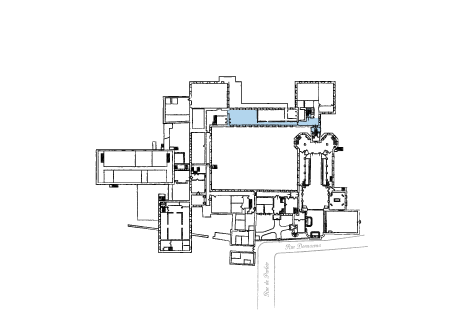Videos
Community Room
Welcome to the assembly room for the Monastery’s sisters. This is where the Nuns hold meetings, parties and group prayers. In the past, they also used this space as a work room for tasks requiring good lighting, such as embroidery. The decor has not changed much over the years. The large, niched wooden wall resembles an altar and reminds us of the sacred nature of the community. Community predecessors, whose pictures are on the walls, keep a watchful eye over.
Video
* The video you will see is a reduced version of the 3D model. The image quality is compressed to suit most devices.
Map - 1e étage


Transcription
We take the stairs to the nuns' wing.
Turn right to the community room.
Let us take a few seconds to observe this room which serves as a place for celebrations, meetings and other gatherings for the nuns.
Letʼs turn to the left corner of the room, closest to us. Under this window you can see a chest, called a "dead chest". We find these in different places in the monastery. These chests were made for both sitting and storage. Fitting perfectly under the window, it was an ideal way to make good use of every inch of space.
Let's move slightly to the right. We are in front of the painting representing Madeleine de la Peltrie. A widow and rich heiress, Mme de la Peltrie sailed to New France in 1639 with the first Ursulines. She was their benefactor and dedicated her life to good works.
Take a few steps to the right. We now observe the portrait of Mary of the Incarnation. It was painted after her death. This is the last remembrance of the face of our holy foundress. It was painted by Hugues Pommier, a known portrait painter at the time.
Let's move to the right again. Between the two windows, we see the portrait of another of our foundresses. She also arrived in 1639, on the same boat as Marie of the Incarnation. On this boat, there were three Ursulines and Mme de la Peltrie. The four had, as mission, the founding of this monastery and the education of young girls. Do you know the name of the first three Ursulines of New France? Marie of the Incarnation, Cecile of the Holy Cross and ... the one represented here: Marie-de-Saint-Joseph-de-La Troche called Mother St. Joseph.
Let's return to the back of the room. In the right corner furthest from us.
The first picture we see on the right wall is of Father Lemoine. He was the chaplain of the community as early as 1854. In 1888, he collaborated in writing the first history book on the Ursulines of New France.
Let’s move along the wall at the right. This time, between the two windows, there is no table, but a clock. At the time, only a few families and religious communities had one. They mostly used hourglasses, bells and sundials to mark time and respect their schedules.
On the right, again, we go to the next portrait. The man here is Father Maguire. He was the chaplain of the Ursulines in 1832 and helped to restore the finances of the monastery after a difficult period. He reformed the rules of the cloister and, after a trip abroad, took inspiration from the best schools to add disciplines such as music to the curriculum of the Ursuline school.
We continue along the wall. This portrait is that of Mgr Plessis. Very early in his career, Joseph-Octave Plessis understood the importance of quality education. An admirer of the English method of education, he encouraged the Ursulines to teach new subjects.
We make a quarter-turn to the right. In the corner, at the base of the wall, we see an iron container and a sink. Since there was no running water at the time, it was convenient to have water nearby.
Let’s go back a little and make a quarter turn right to observe the room one last time before returning to the exit.










